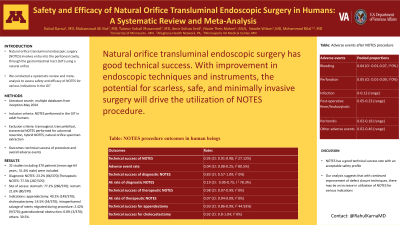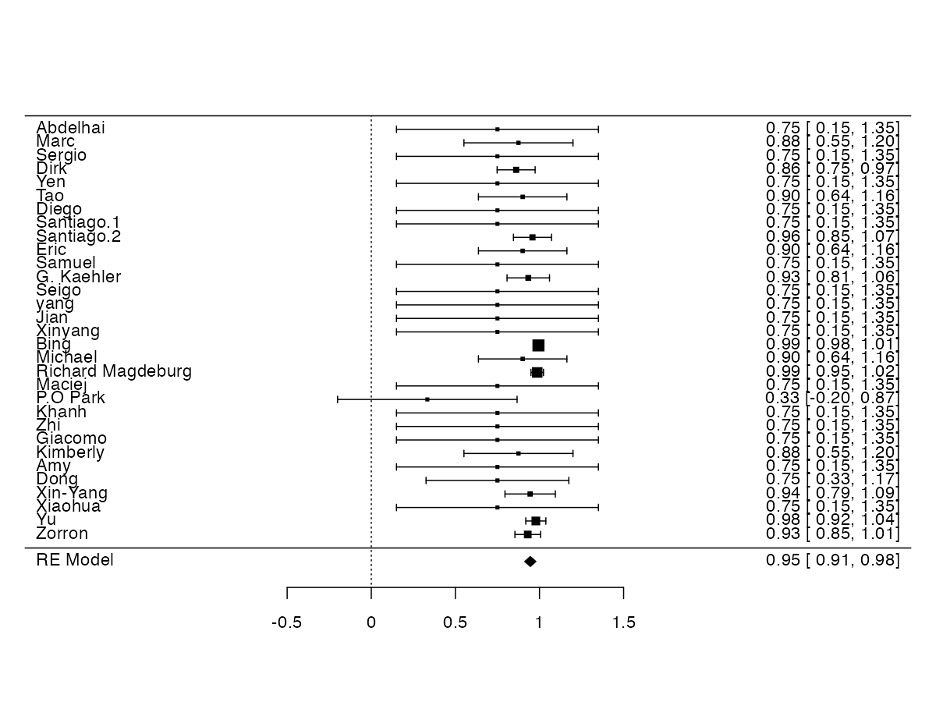Sunday Poster Session
Category: Interventional Endoscopy
P1069 - Safety and Efficacy of Natural Orifice Transluminal Endoscopic Surgery in Humans: A Systematic Review and Meta-Analysis
Sunday, October 27, 2024
3:30 PM - 7:00 PM ET
Location: Exhibit Hall E

Has Audio
- RK
Rahul Karna, MD
University of Minnesota Medical Center
Minneapolis, MN
Presenting Author(s)
Rahul Karna, MD1, Muhammad Ali Butt, MD2, Taimur S. Muzammil, MD2, Amir Sultan Seid, MD3, Nicole Theis-Mahon, 3, Natalie Wilson, MD3, Mohammad Bilal, MD4
1University of Minnesota Medical Center, Minneapolis, MN; 2Allegheny General Hospital, Pittsburgh, PA; 3University of Minnesota, Minneapolis, MN; 4University of Minnesota and Minneapolis VA Health Care System, Minneapolis, MN
Introduction: Natural orifice transluminal endoscopic surgery (NOTES) involves entry into the peritoneal cavity, through the gastrointestinal tract (GIT) using a natural orifice. Despite more than 2 decades of existence, the indications, safety and outcomes of NOTES is not well established. We conducted a systematic review and meta-analysis to assess safety and efficacy of NOTES for various indications in the GIT.
Methods: A literature search of multiple databases was conducted (inception-May 2024) to include cases of NOTES performed in the GIT in adult humans. We excluded cases of transvaginal, transumbilical and hybrid NOTES, transrectal NOTES performed for colorectal resection, as well as well natural orifice specimen extraction or when site of access could not be identified. Primary outcomes were technical success of procedure and overall adverse events (AEs). Secondary outcomes were technical success and AEs stratified by indication of procedure. A meta-analysis of proportions was performed for all outcomes.
Results: Out of 1953 citations, 32 studies including 370 patients (mean age 64 years , 51.6% male) were analyzed. 23.2% (86/370) were performed for diagnostic indications while 77.5% (287/370) were therapeutic. Stomach was the most common access site in 77.2% (286/370) followed by rectum in 21.6% (80/370). Common indications were: appendectomy: 40.2% (149/370); cholecystectomy: 14.5% (54/370); intraperitoneal salvage of stents migrated during procedure: 2.42% (9/370); gastroduodenal obstruction: 0.8% (3/370); others: 30.5%. Pooled technical success rate was 0.95 (CI: 0.91-0.98; I2 27.12%) with overall AE rate 0.04 (CI: 0.08-0.25; I2 80.5%) (Figure 1). Table 1 summarizes the AEs. Subgroup analysis revealed pooled technical success of diagnostic NOTES: 0.83 (CI: 0.57-1.09; I2 0%) and therapeutic NOTES: 0.98 (CI: 0.97-0.99; I2 0%). Pooled AE rate of diagnostic NOTES was 0.19 (CI: 0.00-0.75; I 2 78.3%) and therapeutic NOTES was 0.07 (CI: 0.04-0.09; I2 0%). Further analysis revealed pooled technical success for appendectomy: 0.93 (CI: 0.86-0.99; I2 44.93%) and cholecystectomy: 0.92 (CI: 0.8-1.04; I2 0%). Pooled AE rate of appendectomy was 0.05 (CI: 0.09-0.91, I2 0%)and cholecystectomy was 0.09 (CI: 0.00-0.2, I2 0%).
Discussion: NOTES has a good technical success rate with an acceptable safety profile. Our analysis suggests that with continued improvement of defect closure techniques, there may be an increase in utilization of NOTES for various indications.

Note: The table for this abstract can be viewed in the ePoster Gallery section of the ACG 2024 ePoster Site or in The American Journal of Gastroenterology's abstract supplement issue, both of which will be available starting October 27, 2024.
Disclosures:
Rahul Karna, MD1, Muhammad Ali Butt, MD2, Taimur S. Muzammil, MD2, Amir Sultan Seid, MD3, Nicole Theis-Mahon, 3, Natalie Wilson, MD3, Mohammad Bilal, MD4. P1069 - Safety and Efficacy of Natural Orifice Transluminal Endoscopic Surgery in Humans: A Systematic Review and Meta-Analysis, ACG 2024 Annual Scientific Meeting Abstracts. Philadelphia, PA: American College of Gastroenterology.
1University of Minnesota Medical Center, Minneapolis, MN; 2Allegheny General Hospital, Pittsburgh, PA; 3University of Minnesota, Minneapolis, MN; 4University of Minnesota and Minneapolis VA Health Care System, Minneapolis, MN
Introduction: Natural orifice transluminal endoscopic surgery (NOTES) involves entry into the peritoneal cavity, through the gastrointestinal tract (GIT) using a natural orifice. Despite more than 2 decades of existence, the indications, safety and outcomes of NOTES is not well established. We conducted a systematic review and meta-analysis to assess safety and efficacy of NOTES for various indications in the GIT.
Methods: A literature search of multiple databases was conducted (inception-May 2024) to include cases of NOTES performed in the GIT in adult humans. We excluded cases of transvaginal, transumbilical and hybrid NOTES, transrectal NOTES performed for colorectal resection, as well as well natural orifice specimen extraction or when site of access could not be identified. Primary outcomes were technical success of procedure and overall adverse events (AEs). Secondary outcomes were technical success and AEs stratified by indication of procedure. A meta-analysis of proportions was performed for all outcomes.
Results: Out of 1953 citations, 32 studies including 370 patients (mean age 64 years , 51.6% male) were analyzed. 23.2% (86/370) were performed for diagnostic indications while 77.5% (287/370) were therapeutic. Stomach was the most common access site in 77.2% (286/370) followed by rectum in 21.6% (80/370). Common indications were: appendectomy: 40.2% (149/370); cholecystectomy: 14.5% (54/370); intraperitoneal salvage of stents migrated during procedure: 2.42% (9/370); gastroduodenal obstruction: 0.8% (3/370); others: 30.5%. Pooled technical success rate was 0.95 (CI: 0.91-0.98; I2 27.12%) with overall AE rate 0.04 (CI: 0.08-0.25; I2 80.5%) (Figure 1). Table 1 summarizes the AEs. Subgroup analysis revealed pooled technical success of diagnostic NOTES: 0.83 (CI: 0.57-1.09; I2 0%) and therapeutic NOTES: 0.98 (CI: 0.97-0.99; I2 0%). Pooled AE rate of diagnostic NOTES was 0.19 (CI: 0.00-0.75; I 2 78.3%) and therapeutic NOTES was 0.07 (CI: 0.04-0.09; I2 0%). Further analysis revealed pooled technical success for appendectomy: 0.93 (CI: 0.86-0.99; I2 44.93%) and cholecystectomy: 0.92 (CI: 0.8-1.04; I2 0%). Pooled AE rate of appendectomy was 0.05 (CI: 0.09-0.91, I2 0%)and cholecystectomy was 0.09 (CI: 0.00-0.2, I2 0%).
Discussion: NOTES has a good technical success rate with an acceptable safety profile. Our analysis suggests that with continued improvement of defect closure techniques, there may be an increase in utilization of NOTES for various indications.

Figure: Forest Plot of technical success of NOTES procedure in humans
Note: The table for this abstract can be viewed in the ePoster Gallery section of the ACG 2024 ePoster Site or in The American Journal of Gastroenterology's abstract supplement issue, both of which will be available starting October 27, 2024.
Disclosures:
Rahul Karna indicated no relevant financial relationships.
Muhammad Ali Butt indicated no relevant financial relationships.
Taimur Muzammil indicated no relevant financial relationships.
Amir Sultan Seid indicated no relevant financial relationships.
Nicole Theis-Mahon indicated no relevant financial relationships.
Natalie Wilson indicated no relevant financial relationships.
Mohammad Bilal: Boston Scientific – Consultant. Cook endoscopy – Speakers Bureau.
Rahul Karna, MD1, Muhammad Ali Butt, MD2, Taimur S. Muzammil, MD2, Amir Sultan Seid, MD3, Nicole Theis-Mahon, 3, Natalie Wilson, MD3, Mohammad Bilal, MD4. P1069 - Safety and Efficacy of Natural Orifice Transluminal Endoscopic Surgery in Humans: A Systematic Review and Meta-Analysis, ACG 2024 Annual Scientific Meeting Abstracts. Philadelphia, PA: American College of Gastroenterology.
